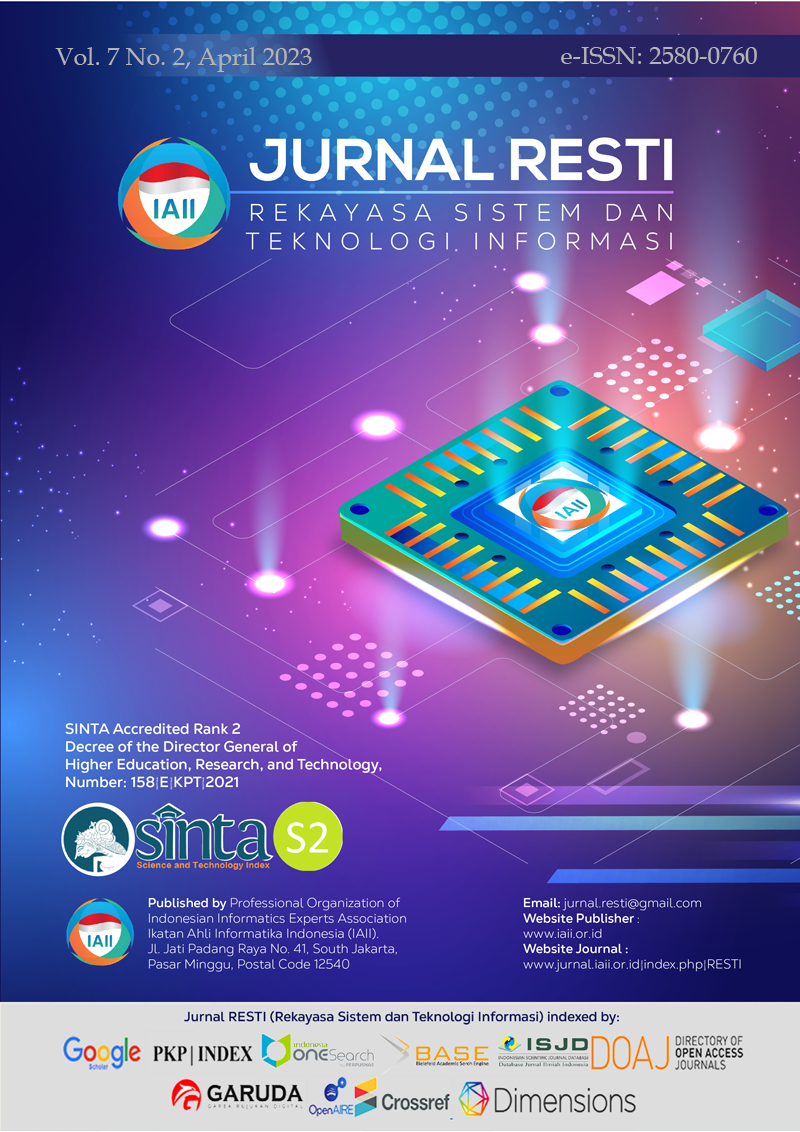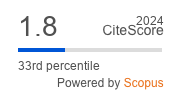The Integrated Information System Implementation Strategy in Korlantas Polri Based on the Zachman Framework Approach
Abstract
Traffic Police Corps (Korlantas Polri) is the executor of the main duties of the Indonesian National Police in the areas of security, safety, order and smooth traffic. Korlantas has some information that can be accessed by the public, namely information on congestion, accidents, traffic flow status, vital objects, road conditions, data and visual images from CCTV, public service conditions, and traffic infrastructure. However, these data are stand alone and not integrated with their respective applications and systems. The purpose of this study is to analyze the strategy for implementing an integrated information system at Korlantas Polri and what steps can be taken to integrate the existing system. This study uses the Zachman Framework which is adapted to Enterprise Architecture Planning (EAP) and qualitative data collection methods by interviewing stakeholders who are involved in managing information systems at Korlantas Polri. The results obtained are the need for a data warehouse by implementing an AI based integrated database system, Geospatial Information System, Business Intelligence and DSS, as well as Smart Visualization to visualize existing data. Then standardize the need for equipment and support for improving the ability of personnel in the IT field.
Downloads
References
L. Larasati and W. A. Kusuma, “Integrated information system development planning at tropical biopharmaca research center using enterprise architecture planning,” in IOP Conference Series: Earth and Environmental Science, Jul. 2019, vol. 299, no. 1. doi: 10.1088/1755-1315/299/1/012053.
T. Iyamu, “Understanding the Complexities of Enterprise Architecture through Structuration Theory,” Journal of Computer Information Systems, vol. 59, no. 3, pp. 287–295, May 2019, doi: 10.1080/08874417.2017.1354341.
S. H. Kaisler, F. Armour, and M. Valivullah, “Enterprise architecting: Critical problems,” in Proceedings of the Annual Hawaii International Conference on System Sciences, 2005, p. 224. doi: 10.1109/hicss.2005.241.
M. G. R. M. Defriani, “E-Government Architectural Planning Using Federal Enterprise Architecture Framework in Purwakarta Districts Government,” 2019.
S. T. Hari Supriadi and S. T. Endang Amalia, “University’s enterprise architecture design using enterprise architecture planning (EAP) based on the Zachman’s framework approach,” International Journal of Higher Education, vol. 8, no. 3, pp. 13–28, 2019, doi: 10.5430/ijhe.v8n3p13.
N. Benkamoun, W. ElMaraghy, A. L. Huyet, and K. Kouiss, “Architecture framework for manufacturing system design,” in Procedia CIRP, 2014, vol. 17, pp. 88–93. doi: 10.1016/j.procir.2014.01.101.
A. Dorofeev, N. Altukhova, N. Filippova, T. Pashkova, and M. Ponomarev, “Development of transportation management system with the use of ontological and architectural approaches to ensure trucking reliability,” Sustainability (Switzerland), vol. 12, no. 20, pp. 1–16, Oct. 2020, doi: 10.3390/su12208504.
H. Guo, J. Li, and S. Gao, “Understanding challenges of applying enterprise architecture in public sectors: A technology acceptance perspective,” in Proceedings - IEEE International Enterprise Distributed Object Computing Workshop, EDOCW, Oct. 2019, vol. 2019-October, pp. 38–43. doi: 10.1109/EDOCW.2019.00020.
I. Shaanika and T. Iyamu, “Developing the enterprise architecture for the Namibian government,” The Electronic Journal of Information Systems in Developing Countries, vol. 84, no. 3, p. e12028, May 2018, doi: 10.1002/isd2.12028.
B. Gobin-Rahimbux et al., “A Systematic Literature Review on ICT Architectures for Smart Mauritian Local Council,” Transforming Government: People, Process and Policy, vol. 14, no. 2. Emerald Group Holdings Ltd., pp. 261–281, Jun. 15, 2020. doi: 10.1108/TG-07-2019-0062.
B. D. Rouhani, “Factors That Affect the Effectiveness of Enterprise Architecture Implementation Methodology,” International Journal of Economics and Management Engineering, 2015.
R. Winter and R. Fischer, “Essential layers, artifacts, and dependencies of enterprise architecture,” in Proceedings - 2006 10th IEEE International Enterprise Distributed Object Computing Conference Workshops, EDOCW2006, 2006, pp. 30–38. doi: 10.1109/EDOCW.2006.33.
D. Simon, K. Fischbach, and D. Schoder, “Enterprise architecture management and its role in corporate strategic management,” Information Systems and e-Business Management, vol. 12, no. 1, pp. 5–42, Feb. 2014, doi: 10.1007/s10257-013-0213-4.
M. Thirasakthana and S. Kiattisin, “Sustainable government enterprise architecture framework,” Sustainability (Switzerland), vol. 13, no. 2, pp. 1–27, Jan. 2021, doi: 10.3390/su13020879.
M. Lnenicka and J. Komarkova, “Developing a government enterprise architecture framework to support the requirements of big and open linked data with the use of cloud computing,” Int J Inf Manage, vol. 46, pp. 124–141, Jun. 2019, doi: 10.1016/j.ijinfomgt.2018.12.003.
Government of Indonesia, “Undang-Undang Nomor 2 Tahun 2002 tentang Kepolisian Negara Republik Indonesia,” 2002.
S. I. M. Al-Nasrawi, An Enterprise Architecture Mapping Approach for Realizing e-Government. 2013.
Presiden Republik Indonesia, “Perpres Nomor 39 Tahun 2019 tentang Satu Data Indonesia,” 2019.
S. S. T. Wibowo, Improving Data Secutiry, Interoperability, and Veracity using Blockchain for One Data Governance, Case Study of Local Tax Big Data. 2019.
B. Anthony Jnr, “Managing digital transformation of smart cities through enterprise architecture–a review and research agenda,” Enterprise Information Systems, vol. 15, no. 3. Taylor and Francis Ltd., pp. 299–331, 2021. doi: 10.1080/17517575.2020.1812006.
A. Sifaunajah, T. Hariono, Moh. A. Aris Widya, P. Airlangga, Sujono, and S. Sufaidah, “Model Implementation of Application Programming Interface for E-Goverment Data Integration,” in 2022 Seventh International Conference on Informatics and Computing (ICIC), Dec. 2022, pp. 1–6. doi: 10.1109/ICIC56845.2022.10006904.
K. R. Putra and F. Anggreani, “Perancangan Arsitektur Enterprise Pada Instansi Pemerintahan: Systematic Literature Review,” Computing and Education Technology Journal (CETJ), 2022, [Online]. Available: http://ppjp.ulm.ac.id/journals/index.php/cetj
J. N. Merrill and John Merrill Foundation, Day pilgrimage walks to Cambridgeshire’s cathedrals. 2018.
B. Gunawan Sudarsono, R. A. A, J. Fernandes Andry, P. Ranting, and A. Binti Abd Rahman, “Redesign The FOrwarding Company’s Business Process Using Zachman Framework,” J Theor Appl Inf Technol, vol. 31, no. 16, 2020, [Online]. Available: https://www.researchgate.net/publication/344025513
S. H. Spewak, Enterprise architecture planning: developing a blueprint for data, applications, and technology. 1993.
U. Ulmi, A. P. G. Putra, Y. D. P. Ginting, I. L. Laily, F. Humani, and Y. Ruldeviyani, “Enterprise Architecture Planning for Enterprise University Information System Using the TOGAF Architecture Development Method,” in IOP Conference Series: Materials Science and Engineering, Aug. 2020, vol. 879, no. 1. doi: 10.1088/1757-899X/879/1/012073.
S. S. Hilabi, F. L. Gaol, and T. Matsuo, “Enterprise architecture design for regional parliament information systems using the standard government and architecture application (SAGA) framework,” ICIC International, 2021.
B. Indrawan and I. D. Sumitra, “Enterprise Architecture for Higher Education Using Enterprise Architecture Planning Based Three Pillars of Higher Education,” in IOP Conference Series: Materials Science and Engineering, Nov. 2019, vol. 662, no. 3. doi: 10.1088/1757-899X/662/3/032030.
J. J. F. Leonardo, “Design Enterprise Architecture for Industry of Textile Using Zachman Framework,” 2019.
I. Sommerville, Software Engineering, vol. Tenth. 2016.
Copyright (c) 2023 Jurnal RESTI (Rekayasa Sistem dan Teknologi Informasi)

This work is licensed under a Creative Commons Attribution 4.0 International License.
Copyright in each article belongs to the author
- The author acknowledges that the RESTI Journal (System Engineering and Information Technology) is the first publisher to publish with a license Creative Commons Attribution 4.0 International License.
- Authors can enter writing separately, arrange the non-exclusive distribution of manuscripts that have been published in this journal into other versions (eg sent to the author's institutional repository, publication in a book, etc.), by acknowledging that the manuscript has been published for the first time in the RESTI (Rekayasa Sistem dan Teknologi Informasi) journal ;








